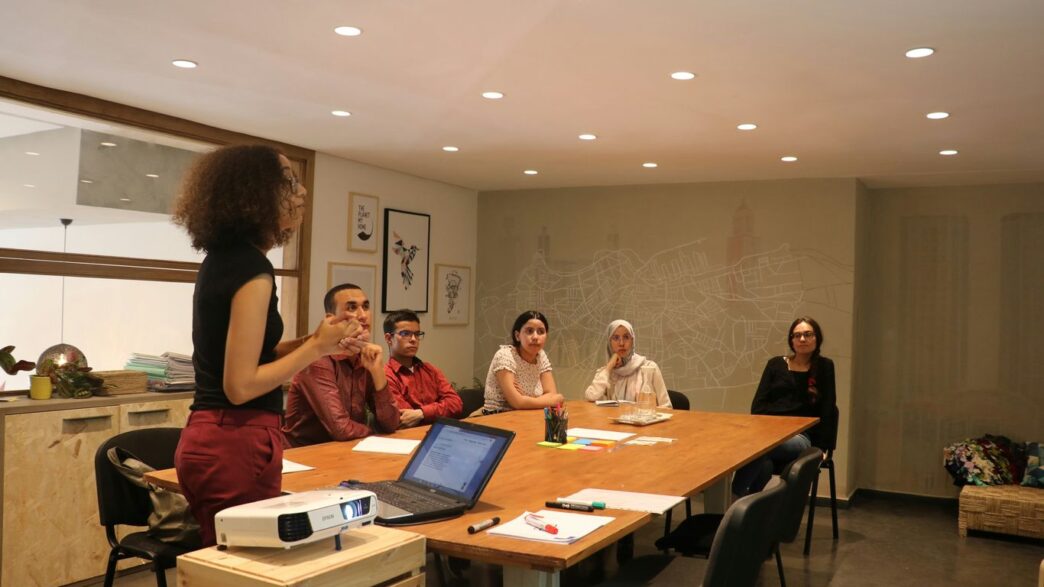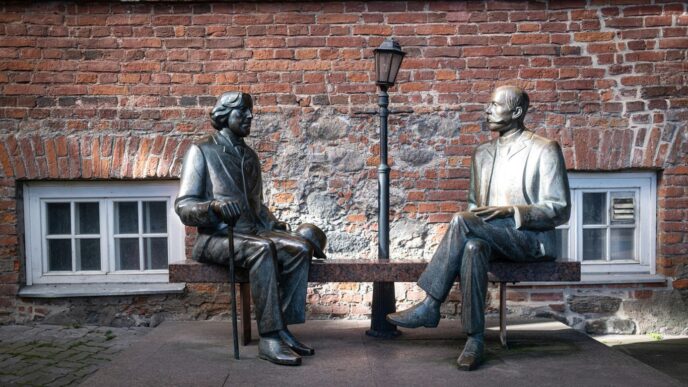Thinking about becoming a media expert in 2025? The media world is changing fast, and there’s a lot more to it than just knowing how to use a camera or edit a video. These days, you’ll need to know how to tell stories that grab attention, work with people from all over the world, and keep up with new tech like AI and VR. Whether you’re just starting out or looking to switch from another field like journalism or marketing, there’s plenty to learn. Here’s what you should focus on if you want to make your mark as a media expert.
Key Takeaways
- Clear, simple communication and strong networking are must-haves for any media expert today.
- Being open to different cultures and working styles helps you connect with bigger, more diverse audiences.
- Storytelling isn’t just about words—using data and new tech can make your stories stand out.
- Managing teams and projects (even remotely) is now a big part of media work.
- Building a digital portfolio and following industry trends will help you stand out in a crowded field.
Foundational Skills Every Media Expert Needs
No matter your background, if you want to be taken seriously in media in 2025, there are some basics you just can’t skip. Being on top of these means you can roll with ever-changing tech, tricky deadlines, and folks from all over the world. Let’s get into what really matters.
Effective Communication in a Global Market
When you’re working with people from all over, your words matter, maybe more than ever. Clear and concise communication is non-negotiable. Whether you’re pitching ideas to a client in another country or working through a video call with a new teammate, you’ve got to get your point across without confusion. Things that help here include:
- Listening well (not just waiting your turn to talk!)
- Adjusting your style depending on who you’re working with
- Making your emails and messages straightforward and professional
Good news? These are things you can actively practice. A bit of patience and a sense of humor help too.
Building Strong Professional Networks
You can have all the talent in the world, but the media industry runs on relationships. Getting to know the right people—and making sure they know you and your work—opens doors you might not even know exist yet. Here’s how to get started:
- Attend at least a couple of real-world and virtual events each year
- Connect with people on industry platforms like LinkedIn
- Follow up with folks after meetings or collaborations, don’t just vanish
It’s not about having the biggest contact list. It’s about keeping in touch with people who challenge you and help you grow. Sometimes those connections come from unexpected places, like a quick chat after a video training session.
Cultural Competency and Inclusivity
Media doesn’t happen in a bubble. Understanding and respecting different backgrounds isn’t just "a nice thing"—viewers and brands expect it now. What does this look like in practice?
- Paying attention to whose voices are being included or left out in your stories
- Continuing to learn about cultures outside your own (books, podcasts, actual conversations)
- Checking your work for stereotypes or assumptions—ask someone if you’re not sure
Some folks think this is tricky, but honestly, it’s just about being curious and willing to learn.
Adaptability and Problem-Solving
The media industry changes fast. Sometimes you’re running on three hours of sleep, juggling a last-minute script change, and the internet just went down. What do you do? Being flexible and thinking on your feet is key.
Top habits for staying adaptive:
- Stay organized, but have a backup plan (or two)
- When something goes wrong, take a breath before reacting
- Don’t be afraid to ask questions or crowdsource solutions
Here’s a quick table comparing common production problems and practical solutions:
| Problem | Quick Fix |
|---|---|
| Audio isn’t syncing | Check connections, reboot gear |
| Team member is late | Reassign tasks, adjust schedule |
| Footage is corrupted | Use backup files, reshoot ASAP |
If you want to work in media, being the person who says, “Don’t worry, we’ll sort this out,” will make you everyone’s favorite coworker.
Mastering Storytelling and Narrative Development

Storytelling is the engine that keeps media in motion—it’s what pulls people in, keeps them watching or reading, and sometimes even shapes trends. If you’re aiming to work in media in 2025, you’ll need more than just a decent camera or editing skills. Great media starts with meaningful stories, shaped by skill and awareness. Here’s a plain look at how to get there.
Crafting Compelling Stories Across Genres
Telling a story well means understanding what works for different formats: news, documentary, advertising, podcasts, or entertainment. Each one needs a different approach:
- Start with a solid idea—ask yourself what the core message is.
- Know your audience. Are you talking to teenagers, parents, professionals?
- Structure matters: every story can benefit from a clear beginning, middle, and end—even a 30-second ad.
- Use visuals and audio to reinforce your narrative. Don’t just tell—show.
A common mistake: trying to impress with big words or super complex ideas. Simple, honest storytelling nearly always wins.
Incorporating Diverse Perspectives in Content
Including different voices in your work isn’t just the right thing to do, it also makes your stories better. People want to see themselves reflected in the world they watch or read about. Here’s how you can do it:
- Seek input from people with different backgrounds or experiences than your own.
- Stop and ask if your story leaves anyone out—if it does, consider ways to fix that.
- Don’t rely on stereotypes. Dig deeper with your research and interviews.
- Give credit—let contributors share their voices openly.
This might feel awkward at first, but it leads to richer stories and wider audiences.
Utilizing Data-Driven Storytelling Techniques
Today, data isn’t just for tech folks. It can change the way you tell stories, helping you figure out what your audience cares about—and how they engage with your work. Here’s how you can bring data into your media process:
- Look at analytics on what types of stories perform best.
- Use surveys and feedback to shape your ideas.
- Visualize key facts with infographics or quick stats in your content.
Example table: Types of Data That Guide Storytelling in 2025
| Data Type | How It Helps | Easy Way to Use It |
|---|---|---|
| Viewer/Listener Demographics | Focus your tone and content | Social media analytics |
| Engagement Metrics | Know where people lose interest | YouTube retention stats |
| Search Trends | Find topics people care about now | Google Trends |
Data isn’t there to tell the whole story—it’s just a tool to help make better decisions about what you create and share.
Media in 2025 is busy and loud, but the best stories still stand out. Try new angles, bring everyone into the conversation, and don’t be afraid to learn from both numbers and people. That’s how you’ll make your mark in media.
Technical Proficiency for Modern Media Experts

You can’t really call yourself a media expert in 2025 unless you can handle a messy list of tools and tech. It’s not just about turning on the camera anymore; you’ve got to know your way around editing suites, data analytics, and even a bit of artificial intelligence. Whether you’re working on your own or jumping between teams, staying updated isn’t just smart, it’s survival. Let’s break down the key areas to focus on.
Production Tools and Post-Production Mastery
If you spend your days in video or audio production, it’s impossible to ignore how quickly editing software changes. Producers are expected to juggle everything from camera setup to advanced editing and mixing. Here’s a rundown you’ll want to keep close:
- Learn the basics of popular editing software (like Adobe Premiere, DaVinci Resolve, or Final Cut Pro).
- Understand sound mixing and mastering, even if you’re not an audio person.
- Get comfortable with motion graphics tools and animation basics.
- Know how to troubleshoot technical glitches on the fly — because something always goes wrong during a deadline.
Fluency in multiple production and editing tools hands you a much wider range of career options. It also lets you adapt your workflow instead of getting stuck when one piece of gear or software goes down.
Leveraging AR, VR, and AI in Content Creation
Augmented reality, virtual reality, and artificial intelligence aren’t fringe anymore. These tools are showing up everywhere, from marketing videos to documentaries, and even short news stories. Here are the main things to keep in mind:
- Explore free or affordable AR and VR creation tools to start building immersive content.
- Experiment with AI platforms for creative tasks like automated editing, subtitling, or even some script writing.
- Take basic online workshops on AR/VR and AI—these will color your future content strategy.
Media pros who play around with these tools early on stand out, especially when clients or employers want something fresh or interactive.
Staying Ahead with Digital Media Platforms
Everyone talks about social channels, but actually keeping up with them is a full-time job. Algorithms change, new platforms pop up, and what worked last year is probably old news now. Here’s what you’ll need to stay in the loop:
- Track the features, trends, and rules for popular social and streaming platforms. If you’re not sure where to start, focus on the places that work best for your voice and content style—focus on the social platforms that work best for you.
- Get used to analytics dashboards. Reading data on how content performs is a skill in itself, and it helps you spot opportunities faster than instinct alone.
- Practice regular content updates and cross-posting—keeping a consistent schedule matters more than ever.
Quick Comparison: Content Tools by Type
| Tool Type | Popular Options | Primary Use |
|---|---|---|
| Video Editing | Premiere, DaVinci, Final Cut | Editing, color grading |
| Audio Production | Audition, Logic Pro, Pro Tools | Mixing, mastering |
| Animation/Motion | After Effects, Blender, Canva | Graphics, titles, VFX |
| AR/VR Creation | Unity, Unreal, SparkAR | Immersive content |
| AI Tools | Descript, Runway, Lumen5 | Editing, auto-captioning |
If you can keep up with the new tech and put it to good use, you’re setting yourself up for a real shot at modern media success. And remember, it’s the hands-on practice that’ll make you stand out—not just knowing big words off a syllabus.
Leadership and Collaboration in Media Production
Being in charge of a media project is one thing—getting everyone to actually work together, especially if they’re spread out across cities or even time zones, is a whole different ballgame. Leadership in this field isn’t about barking orders; it’s about finding ways to keep teams connected, engaged, and moving toward a real deadline, even when everything gets chaotic.
Managing Creative and Technical Teams Remotely
Keeping remote teams motivated in media production is as much about clear daily communication as it is about the big-picture vision. Some days, just getting everyone on the same call feels like a miracle. The best team leads try to:
- Set up short, daily check-ins so tasks don’t fall behind.
- Use shared project boards (think Trello or Asana) so everyone knows what they’re supposed to do.
- Trust people with their schedules, but always circle back for regular updates.
A lot of folks coming from related backgrounds, like technology journalism, find the transition easier if they already know how to work across multiple digital platforms and can keep audience needs in sharp focus [building an audience].
Fostering Collaborative and Inclusive Work Cultures
Creative teams are a weird mix—producers, camera crew, writers, designers. Getting these different minds to work together is tough, especially with so many personalities in one (virtual) room. Here are some ways production leaders make it happen:
- Encourage open feedback—nobody can fix problems if people are afraid to speak up.
- Rotate roles or tasks when possible, so everyone gets to see things from a new angle.
- Make sure meetings and feedback loops include voices from all backgrounds, not just the loudest.
Inclusivity isn’t just a side note anymore; it’s a real part of what makes media production click. Diverse perspectives push projects in new directions.
Project Management from Concept to Completion
A media project can go off the rails so quickly. From that first pitch to the final edit, someone needs to keep things running. This means:
- Breaking each milestone into bite-sized tasks with clear owners.
- Tracking time spent and money burned (because the budget runs out fast).
- Keeping everyone focused on the end goal, even when new ideas pop up halfway through.
Here’s a quick breakdown of common project stages and who’s involved:
| Stage | Key Personnel | Typical Tasks |
|---|---|---|
| Pre-production | Producer, Writer | Concept, Script, Scheduling |
| Production | Director, Crew | Filming, Sound, Logistics |
| Post-production | Editor, Designer | Editing, Graphics, Sound Mix |
| Delivery | Producer, Marketing Lead | Final Upload, Promotion |
Effective leaders see the whole board, but also pay attention to small details. The best ones know how to keep things flexible, because almost nothing goes exactly as planned. Real progress in media production depends on a mix of planning, compromise, and—more often than not—a healthy dose of patience.
Cross-Platform Content Strategy and Distribution
Creating something great is only half the work; you need to make sure it gets seen by people everywhere. In 2025, sharing your content on more than one platform isn’t just helpful, it’s the standard. Every media specialist needs to know how to get their work noticed across streaming, social media, and even the ever-changing new apps that pop up each year. You don’t want to drop the same thing everywhere and hope for the best. Instead, you want a plan that makes the most of each place.
Tailoring Content for Streaming and Social Media
Different spaces need different styles. Streaming platforms like Netflix and YouTube ask for longer formats and higher production. Social media works better with shorter clips, snappy images, and quick captions that get people to share.
- Short-form videos for places like TikTok or Instagram Reels grab attention fast.
- Livestreams or behind-the-scenes podcasts work well on platforms that support real-time interaction, like Twitch or Twitter/X Spaces.
- For traditional video on demand, like Hulu or Amazon Prime, you might need to invest in subtitles, multiple language tracks, or regional edits to boost your chances.
Here’s a quick table comparing common distribution tactics by platform:
| Platform | Best Content Type | Key Benefit |
|---|---|---|
| TikTok / Reels | Short-form, vertical | Viral potential |
| YouTube | Long-form, series | Searchable, evergreen |
| Twitch | Livestreams | Real-time viewer feedback |
| Netflix / Hulu | Full episodes/movies | Prestige, global reach |
Quality and format matter as much as the story you’re telling.
Maximizing Audience Engagement Across Channels
You can’t just slap the same video everywhere and walk away. People act differently depending on where they’re watching.
- Study what gets people talking and sharing on every platform you use.
- Schedule your releases to catch people when they’re active—not just whenever it’s ready.
- Respond to comments and join conversations; people love when creators talk back. This helps your content show up more thanks to the wild world of content algorithms.
Using top distribution tools like those found in leading content distribution platforms can also boost your reach a lot more than just organic posts.
Managing Digital Portfolios and Branding
If you want to stand out, keep all your best work in a portfolio. Give each piece a little context. What was the goal? What platforms did you use? What results did you see?
Good media workers:
- Use simple portfolio sites (like Behance, Vimeo, or a personal site).
- Update their bios and links regularly on every channel.
- Show both their range (lots of different types of work) and consistency (their work always looks like theirs).
This doesn’t just show off your skills. It makes it easy for future clients, employers, or fans to get a solid sense of what you can do, no matter where they first find you.
Evolving Career Pathways for Aspiring Media Experts
Breaking into media isn’t as linear or old-fashioned as it used to be. In 2025, the path to becoming a media professional is more flexible, with options for both newcomers and people switching fields. Whether you’re building up your first portfolio or already have experience from a related job, there’s a route for just about everyone.
Building a Portfolio in the Digital Age
Showing your work online is now expected. Your portfolio acts as both a resume and your first audition. Here’s how to make it count:
- Feature a variety of projects—short videos, podcasts, blog posts, anything that shows your creative range.
- Use social media and personal websites to highlight your best work. Interact with other creators; sometimes, a comment or DM turns into a collaboration.
- Regularly update your portfolio with new content and remove outdated work.
- Highlight any experience working with international teams or platforms, since global reach is key now.
For both individuals and small teams looking to get started, checking out the top freelance groups for video production can offer solid ideas—and connections.
Transitioning from Related Fields like Journalism or Marketing
If your background is in journalism, public relations, or digital marketing, you might already have many of the skills media employers want: writing, reporting, and understanding audiences. But you’ll need to adapt:
- Learn basic video and audio editing through free or inexpensive courses.
- Pick up hands-on skills in social media management and platform algorithms.
- Take a few online classes on analytics, since understanding data is now part of almost every role.
- Find past projects that fit into media—maybe a campaign, a story series, or a branded video—and feature these upfront in your portfolio.
Navigating Industry Specializations
The media world is full of niches, from analytics to immersive tech. It’s smart to figure out what fits you and focus your efforts. Some in-demand areas include:
- Video production (tutorials, promos, animations)
- Social media management
- Podcast and audio production
- Analytics and performance insights
- AR/VR and new media
To help compare which paths are trending, here’s a simple table using recent growth numbers:
| Field | Average Annual Growth (2022-2025) |
|---|---|
| Video Content Production | 9% |
| Media Analytics | 11% |
| Podcasting & Audio | 7% |
| Immersive Media (AR/VR) | 13% |
| Social Media Strategy | 8% |
Keep tracking what’s popular by joining online groups and watching industry trends—many pros recommend following networks or connecting with other media freelancers for ideas.
Finally, remember: media roles often blend creative and technical work, so a bit of learning each year goes a long way. And don’t hesitate to collaborate with people from different countries or specialties; it’s become a regular part of the job.
Emerging Trends and Specializations in Media Expertise
The media field never really stands still—just when you think you’ve got it figured out, some new technology or trend comes barreling in. If you’re aiming to stay ahead, it’s smart to keep an eye on what’s just starting to catch fire. In 2025, some areas are changing so fast that what was new two years ago already looks a little stale. Here’s where things are picking up:
Analytics, AI, and Predictive Modeling
Media folks these days spend a lot more time staring at dashboards and graphs than you might expect. But it’s not just about tracking who clicked play—it’s about understanding why people do what they do. Here’s what’s new in this area:
- Predictive modeling lets you guess audience preferences before they know what they want themselves.
- AI tools are now doing the work of sorting through massive piles of content, finding patterns, and making recommendations much faster than any human could.
- Analysts are called on to explain what the data means to people who don’t care about numbers—all in plain English, not technical mumbo-jumbo.
A quick look at new AI-driven job roles:
| Role Title | Main Goal | Skills Needed |
|---|---|---|
| AI Media Strategist | Optimize AI-generated content | Data analysis, AI |
| Generative Content Performance Analyst | Study success of AI content | Python, statistics |
| Disinformation & Narrative Analyst | Spot fake news trends | Social listening, ML |
Sustainability and Eco-Conscious Production
Green trends aren’t going away—in fact, they’re front and center now. Media companies face pressure to show they care about the planet and people, and that’s changing what gets made and how. Here’s how sustainability is shaping media careers:
- More productions are using eco-friendly materials and energy.
- There’s a push for inclusive, honest storytelling about climate issues.
- Analysts track whether messaging matches up with actual behavior—companies don’t want to get called out for “greenwashing.”
A few ways media pros are measuring this:
- Carbon footprint of campaigns (fewer flights, more remote work)
- Content audits to check for accurate representation
- Policies on waste and recycling in the studio
Metaverse and Immersive Media Opportunities
It might sound like science fiction, but a lot of media creation is moving into virtual worlds. Instead of just watching a show, now you might join in—maybe as a character, or by building something yourself. This opens up a bunch of new jobs that hardly existed a few years ago:
- Analytics specialists measure what people do in virtual spaces, from games to brand pop-ups.
- Storytellers are learning to write for interactive, 3D environments, not just scripts.
- Designers who can build virtual sets, costumes, and effects are in high demand.
A short list of in-demand skills in immersive media:
- Real-time 3D modeling
- UX and interaction design
- Virtual world moderation and management
The bottom line: if you’re thinking about a media career in 2025 and beyond, look for chances to pick up new skills in tech, analytics, and sustainability. Getting comfortable with change—and maybe even enjoying it—will be your best strategy.
Conclusion
So, if you’re thinking about becoming a media expert in 2025, there’s a lot to keep in mind. The industry keeps changing, and the skills you need today might look a bit different tomorrow. But if you focus on clear communication, stay open to learning new tech, and build strong connections with others, you’ll be in a good spot. Don’t forget to pay attention to different cultures and try to include a range of voices in your work. It’s not just about knowing the latest tools or trends—it’s about being flexible, listening well, and working with all kinds of people. The path might not be straightforward, but with some curiosity and a willingness to adapt, you can find your place in the media world. Just keep at it, and remember, everyone starts somewhere.
Frequently Asked Questions
What does a media expert do in 2025?
A media expert in 2025 creates and shares stories using many digital tools. They work with videos, podcasts, social media, and even new tech like virtual reality. Their job is to make content that grabs people’s attention and to share it on the right platforms.
What skills are most important for becoming a media expert?
The most important skills are clear communication, teamwork, and problem-solving. Media experts also need to know how to use the newest technology, like editing software or AI tools. Being able to tell a good story and work well with others is key.
How can I start a career in media if I have no experience?
Start by learning the basics of media production, like making short videos or writing simple scripts. You can join school clubs, take online courses, or help with local projects. Building a small portfolio of your work and connecting with people in the industry will help you get your first job.
Do I need a college degree to become a media expert?
A college degree can help, but it’s not always required. Many people start by learning on their own or through internships. What matters most is showing your skills through real projects and being willing to learn new things.
How is technology changing the media industry?
Technology is making it easier to create and share content. Tools like artificial intelligence, virtual reality, and new editing software help media experts make more interesting and creative work. It also means media experts have to keep learning to stay up-to-date.
What are some new trends in media careers for 2025?
Some new trends include using data to tell better stories, making eco-friendly content, and working with virtual worlds like the metaverse. Media experts are also focusing more on including different voices and making content for many types of platforms, like streaming and social media.














